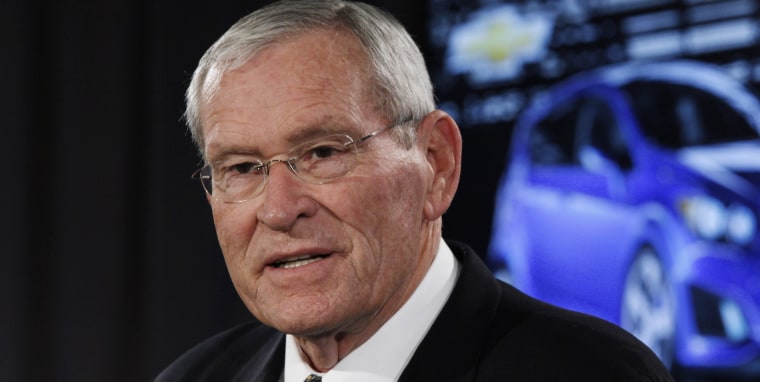The General Motors that has emerged from bankruptcy is a very different company than the one that went begging for a handout from Washington in late 2008. At least it is trying to be.
That's in part due to the efforts of a 68-year-old Texan with no auto industry experience who named himself GM's CEO Monday.
Ed Whitacre may have had trouble finding his way around Detroit’s Renaissance Center when he first arrived at GM as non-executive chairman last summer, but in the short time since he has left a clear stamp on the long-troubled automaker, casting out a number of senior executives, sloughing off layers of management and taking aim at a corporate culture that seemed to dread even the most routine decision-making.
A good start, many would say, but now what?
On Tuesday, a day after Whitacre took over as the permanent chief executive, GM announced it salvaged a deal unloading its money-losing Saab unit to Dutch luxury car brand Spyker for a reported $74 million in cash and $326 million in deferred shares.
Not a bad follow-up.
But GM's efforts to streamline its retail distribution system underscore just how difficult it is to restructure a century-old company. Even as Whitacre was meeting with journalists Monday morning, dealers were lining up to meet a deadline to file for arbitration under a congressionally mandated system challenging their dismissal. Over 1,550, or about half so far, are appealing to reopen their showrooms. Even Whitacre has admitted that “hundreds” of dealers will likely win their appeal.
Change doesn’t come easy in Detroit. During Monday’s news conference, Whitacre made several references to the “motivated” work force that he promised will turn GM around. But outsiders warn that the company’s entrenched bureaucracy can turn into what one senior GM executive once described as a “layer of clay,” resistant to doing things differently, no matter what the cost of stasis.
That’s the challenge Whitacre’s cross-town rival, Ford Motor Co. CEO Alan Mulally, discovered when he arrived in town a little more than three years ago. The former Boeing executive parachuted in on an automaker that, at the time, many felt was in worse shape than GM. Ford was running out of cash, short on ideas, weak on product and had a mind-numblingly politicized corporate culture that operated like a collection of principalities, rather than a single entity with a common goal.
Mulally didn’t waste much time on niceties, nor did he follow the rule book. Among other things, he took the unprecedented step of mortgaging virtually all of Ford’s assets to raise the billions he thought might be needed to weather a storm. Whether dumb luck or uncanny vision, that move permitted Ford to skip a federal bailout even as it raced to market an assortment of new and well-reviewed products, such as the Ford Fusion Hybrid and Transit Connect van. The vehicles were named North American Car and Truck of the Year, respectively, this month.
Detroit traditionally has disdained outsiders. That view seemed to be validated in the early 1990s when a slew of non-automotive managers dug the hole even deeper for GM before heading back to places like Procter & Gamble and Bausch & Lomb. But this is a very different environment, one in which the very existence of the Detroit Three is no longer seen as an entitlement.
“I’m still sort of learning this business,” Whitacre proclaimed Monday, with the sort of aw-shucks Texas twang he resorts to when trying to disarm listeners. It’s true, he’s still struggling to understand things like lease residuals, never mind remember all the products in the GM line-up. But Mulally grappled with the same challenges, and if anything, it allowed him to ask the most fundamental question, “Why?”
With Whitacre breathing down their necks, GM’s new top managers are repeating that "Why?" like a mantra. Susan Docherty, the new head of sales and marketing, says she’s discovering all sorts of things, like complex reports no one reads, that no longer need be done.
Of course, as Ford's Mulally has clearly come to comprehend, product is key, whether or not the CEO recalls the name of every offering in the lineup. GM has been getting increasingly positive marks here, with vehicles like the Chevy Malibu, the 2008 North American Car of the Year, and the Chevrolet Equinox crossover, a close runner-up in this year's Truck of the Year contest.
Bringing vehicles to market is a lengthy process, so Whitacre's stamp will take some time to reveal itself, but he is showing strong support for the company's increasing focus on "electrification," something that really takes hold, late this year, with the launch of the Chevy Volt plug-in hybrid.
Significantly, the new CEO and his board gave a thumbs-up to plans to spend $246 million on an electric motor plant, the first for a domestic maker. GM is betting that will give it a critical advantage as more products turn to battery-based propulsion.
Whitacre insists that he’ll still try to commute home to Texas now that he’s in for the long haul as GM CEO. Perhaps he’ll get down there occasionally, but even with his skill at delegating, the task ahead is one that could just as easily keep him occupied 24/7.
“Do I look tired?” the former boss of telecommunications giant SBC asked this reporter. The correct answer, if not necessarily the polite one, was “yes.” But Whitacre also looked surprisingly pleased with the task ahead of him. He’s now got the green light to move ahead with an ambitious agenda, rather than just hold a place for a permanent CEO.
